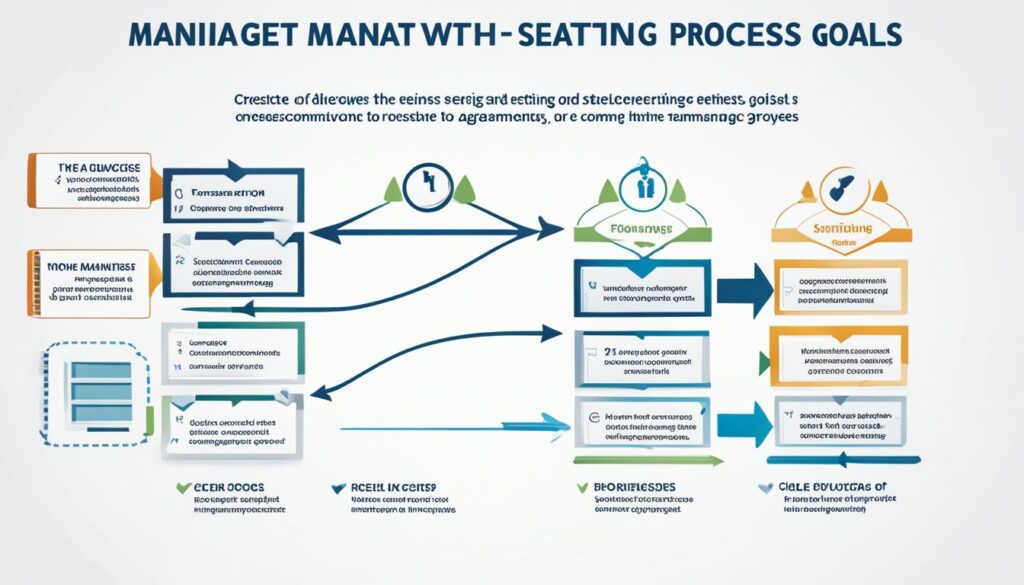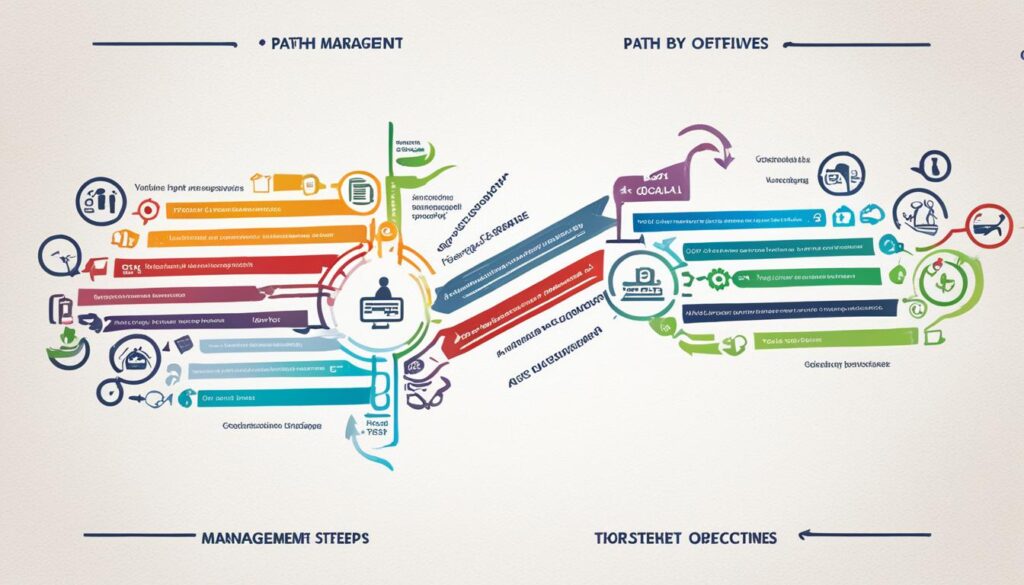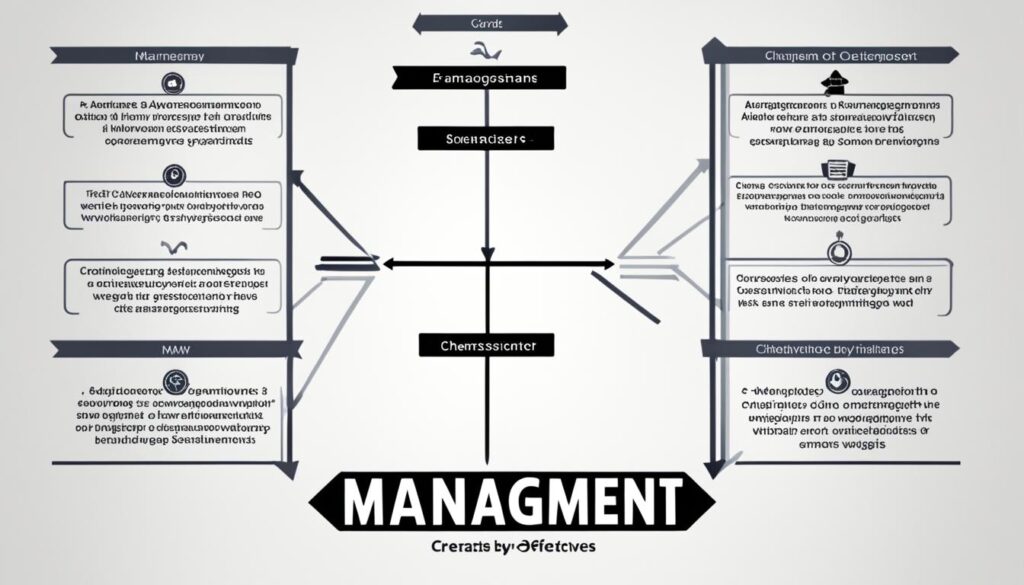Achieve Goals with Management by Objectives Approach

Do you want to improve organizational performance and enhance employee motivation? Are you searching for a goal-setting approach that aligns objectives throughout your company? Look no further than the Management by Objectives (MBO) approach. This strategic performance management technique has revolutionized organizations worldwide, but does it live up to the hype?
Key Takeaways:
- Management by Objectives (MBO) is a goal-setting approach that improves organizational performance.
- MBO aligns objectives throughout the organization and boosts employee motivation and commitment.
- The five-step process of MBO involves defining objectives, sharing them with employees, encouraging participation, monitoring progress, and evaluating performance.
- MBO has advantages such as improved communication, goal alignment, and employee motivation, but it also has drawbacks that need to be addressed.
- Effective performance management requires considering individual aspirations and balancing goals and targets.
Understanding Management by Objectives (MBO)
Management by objectives (MBO) is a strategic framework that promotes goal-setting, measurable targets, and strategic goal alignment within an organization. It is also known as management by planning and involves the establishment of a management information system to compare actual performance with defined objectives.
MBO focuses on enhancing employee motivation and commitment by involving them in the goal-setting process and action plans. By setting challenging but achievable objectives, providing daily feedback, and emphasizing rewards rather than punishment, MBO encourages personal growth and development among employees.
To successfully implement the MBO framework, organizations need the support of top management, clear objectives, and trained managers. This ensures that the goals are communicated effectively and employees are aligned with the strategic direction of the company.
By adopting MBO, organizations can improve goal clarity, foster employee engagement, and enhance overall performance. The framework enables organizations to set measurable goals, align individual and team objectives with broader organizational goals, and regularly monitor progress toward those objectives.
Strategic goal alignment is a crucial element of the MBO process. It ensures that individual goals contribute to the achievement of organizational objectives. By aligning goals at all levels of the organization, MBO creates a sense of purpose and direction, enhancing employee motivation and commitment.
The Key Principles of MBO
| Principle | Description |
|---|---|
| Setting challenging objectives | Goals that stretch employees without being unattainable. They drive performance and personal growth. |
| Providing daily feedback | Regular communication to ensure employees are aware of their progress and can make necessary adjustments. |
| Focusing on rewards | Emphasizing the positive reinforcement of achieving objectives rather than punishing failure. |
| Emphasizing personal growth and development | Encouraging continuous learning and improvement to support employee development. |
By leveraging the MBO framework, organizations can create a culture of goal-oriented performance management, where objectives are clear, progress is monitored, and performance is evaluated based on set targets. This approach promotes employee engagement, increases accountability, and ultimately drives organizational success.

Management by Objectives (MBO) in 5 Steps
Implementing the Management by Objectives (MBO) approach involves a well-defined five-step process. By following these steps, organizations can effectively define objectives, promote employee participation, monitor progress, and evaluate performance. Let’s explore each step in detail:
Step 1: Define Objectives
The first step in MBO is to determine or revise organizational objectives. These objectives should be specific, measurable, acceptable, realistic, and time-bound (SMART). By aligning the objectives with the company’s mission and vision, organizations provide clarity and direction, guiding employees towards shared goals.
Step 2: Encourage Employee Participation
Incorporating employee participation is crucial to the success of MBO. During this step, organizational objectives are translated into individual objectives, and employees are actively involved in setting their own goals. This not only empowers employees but also ensures that their objectives are aligned with the overall organizational goals, fostering a sense of ownership and motivation.
Step 3: Monitor Progress
Monitoring progress is an essential aspect of MBO implementation. By regularly tracking the progress towards the defined objectives, organizations stay informed about the current status and identify any potential deviations. This allows for timely adjustments and interventions, ensuring that goals are on track and in line with the organizational vision.
Step 4: Evaluate Performance
Evaluating performance is a critical step in MBO that enables organizations to assess the achievement of objectives. By measuring employee performance against the set goals, organizations gain insights into individual contributions, identify areas for improvement, and provide feedback for growth and development. This evaluation process helps in recognizing and rewarding employees for their accomplishments, reinforcing a culture of excellence.
Step 5: Reward Achievements
Recognizing and rewarding employees for their achievements is the final step in the MBO process. Rewards can be in various forms, such as monetary incentives, promotions, or additional responsibilities. By acknowledging and appreciating employees’ efforts and successes, organizations reinforce the importance of goal attainment and motivate individuals to strive for excellence.
By following these five steps, organizations can effectively implement the MBO approach, fostering goal alignment, employee participation, continuous progress tracking, performance evaluation, and an overall culture of achievement. Through MBO, organizations can achieve their defined objectives while empowering and motivating their employees.

Advantages and Disadvantages of Management by Objectives (MBO)
Implementing Management by Objectives (MBO) brings with it a range of advantages and disadvantages that organizations need to consider. This performance management approach has the potential to significantly impact employee pride, communication, and quality compromises. Let’s explore these aspects further:
Advantages of MBO
MBO offers numerous benefits that contribute to the success of organizations. Firstly, it boosts employee pride and satisfaction by involving them in goal-setting and decision-making processes. When employees are actively engaged in defining their objectives, they feel a sense of ownership and commitment towards achieving them. This empowerment enhances their job satisfaction and overall motivation, leading to increased productivity.
Secondly, MBO allows for the assignment of tailored goals that align individual aspirations with organizational objectives. Instead of imposing rigid targets, MBO enables managers to collaborate with employees and set personalized goals that leverage their strengths and interests. This approach fosters a sense of relevance and fulfillment, as individuals are more likely to strive for goals that resonate with their own professional growth and development.
Furthermore, MBO promotes effective communication within the organization. Clear and well-defined objectives establish a common language between managers and employees, reducing ambiguity and misunderstandings. Regular feedback exchanges enable continuous dialogue and collaboration, fostering a culture of open communication and transparency.
Lastly, MBO aligns individual goals with company success. By cascading organizational objectives throughout the workforce, MBO ensures that everyone is working towards common goals. This integration enhances collaboration, synergy, and a shared sense of purpose, ultimately driving the organization towards its desired outcomes.
Disadvantages of MBO
While MBO offers significant advantages, it also presents some challenges and potential drawbacks. One concern is that it may lead to neglecting other critical aspects of the company. This happens when the sole focus is on goal achievement, potentially overshadowing other important elements that contribute to success, such as employee well-being, organizational culture, and long-term strategic planning.
Another disadvantage is the potential increase in pressure on employees to meet goals. Setting challenging objectives is essential for driving performance, but an excessive emphasis on target attainment can create a high-stress environment. This pressure may undermine the overall well-being and job satisfaction of employees, leading to burnout and reduced productivity.
Moreover, there is a potential for quality compromises when the relentless pursuit of goals overshadows the importance of maintaining high standards. In the pursuit of meeting targets, employees may rush through tasks, neglect quality control measures, or cut corners to save time. This trade-off between quantity and quality can have detrimental effects on the organization’s reputation and customer satisfaction.
Finally, while MBO is a valuable approach, it may not be suitable for all management responsibilities. Some areas of the organization, such as creative or innovative departments, may require more flexible and adaptive goal-setting approaches. In these cases, rigid objectives and targets may stifle creativity and hinder the exploration of new ideas.
Summary Table: Advantages and Disadvantages of MBO
| Advantages of MBO | Disadvantages of MBO |
|---|---|
| Boosts employee pride and satisfaction | Potential neglect of other aspects of the company |
| Enables tailored goal assignment | Increased pressure on employees to meet goals |
| Improves communication and transparency | Potential compromises in quality |
| Aligns individual goals with company success | May not be suitable for all management responsibilities |

It is essential to weigh the advantages and disadvantages of MBO to determine whether it is the most suitable performance management approach for an organization. By considering these factors, businesses can make informed decisions and customize their approach to achieve optimal results.
Performance Indicators and MBO
Objective-based performance measurement systems, including Management by Objectives (MBO), play a significant role in enhancing organizational performance. However, these systems often neglect to consider the individual needs and aspirations of employees, resulting in demotivation and subpar work. To foster an exceptional workforce, it is crucial to align performance management systems with both individual and organizational needs.
One approach to addressing this issue is through group goal setting and appraisal. By involving employees in the goal-setting process, organizations can ensure that individual objectives align with the overall strategic direction. This collaborative approach promotes a sense of ownership, accountability, and commitment among employees, leading to improved performance.
Another effective strategy is to encourage employees to evaluate their managers’ performance. This enables a two-way feedback loop, allowing managers to understand the needs and expectations of their subordinates while fostering a culture of continuous improvement and open communication. Through this appraisal process, managers can adjust their leadership style, ensuring that individual needs are met and employees feel valued.
Self-examination and conversations about needs and goals are essential for creating a supportive and empowering work environment. Employees should be encouraged to reflect on their personal aspirations, strengths, and areas for development. By facilitating these discussions, organizations can identify areas where individual and company needs may be misaligned and take appropriate actions to bridge the gaps.
Finally, it is crucial to address any discrepancies between individual and organizational needs. By understanding the motivations and requirements of employees, organizations can tailor their performance management systems to accommodate and integrate both sets of needs. This ensures that employees feel valued, supported, and empowered to perform to their fullest potential.

The integration of performance indicators that consider both individual and organizational needs is crucial for creating a thriving and successful workforce. By aligning objectives, encouraging employee participation, and addressing discrepancies, organizations can harness the full potential of their employees and achieve exceptional performance.
Criticisms of MBO
While Management by Objectives (MBO) has its merits, it is not without its flaws. By examining the shortcomings of MBO, we can better understand its limitations and make informed decisions about its implementation.
- Overemphasis on Goals: One of the primary criticisms of MBO is its overemphasis on goals and targets. This singular focus on achieving objectives can create a tunnel vision where employees prioritize goal achievement over other important factors, such as teamwork, creativity, and ethical considerations.
- Neglect of Company Culture and Working Conditions: Another critique of MBO is its limited attention to the broader organizational context. Since MBO primarily focuses on goal-setting and performance measurements, it often fails to consider the impact of company culture, working conditions, and employee well-being on overall performance and motivation.
- Sacrifice of Quality for Quantity: The pursuit of specific goals under MBO can sometimes lead to a sacrifice in quality. Employees may prioritize meeting targets quickly, potentially compromising the quality of their work, processes, and outputs, which could have long-term consequences for the organization.
- Dependence on MBO as a Total System: One common misconception is viewing MBO as a one-size-fits-all solution for all management issues. While MBO can be an effective performance management tool, relying solely on it can overlook the complexity and uniqueness of different areas within the organization, such as creative departments or those requiring more adaptive approaches.
To mitigate these criticisms, it is essential to adopt a balanced approach to goal setting and performance management. Combining MBO with other management techniques, fostering open communication, and addressing broader organizational factors can help maximize the benefits while minimizing the potential drawbacks of MBO.
| Shortcomings of MBO | Impact on Organizations |
|---|---|
| Overemphasis on goals | Risk of neglecting other important factors and aspects of organizational success. |
| Neglect of company culture and working conditions | Potential impact on employee well-being, satisfaction, and overall organizational culture. |
| Sacrifice of quality for quantity | Possible compromise in the quality of work, products, or services. |
| Dependence on MBO as a total system | Risk of overlooking the uniqueness and complexity of different organizational areas. |
Conclusion
Management by objectives is an essential approach for achieving success in organizational performance and employee motivation. By implementing this goal-setting and performance management technique effectively, companies can align objectives throughout the organization, encourage employee participation, monitor progress, and evaluate performance to drive goal achievement and ensure effective performance management.
However, it is crucial to address the shortcomings of MBO and customize the approach to suit the unique needs of each organization. By considering individual aspirations, fostering open communication, and providing feedback, companies can create a collaborative environment that enhances the effectiveness of MBO. Balancing goals and targets is also important to avoid overemphasis on achievements at the expense of other crucial aspects of the company.
With management by objectives, organizations have the opportunity to improve their overall performance by setting clear objectives and empowering employees to contribute actively towards their achievement. By aligning goals, encouraging participation, monitoring progress, and evaluating performance, companies can unleash the full potential of their workforce and drive effective performance management. By leveraging the advantages of MBO while addressing its limitations, companies can pave the way for long-term success and goal attainment.






